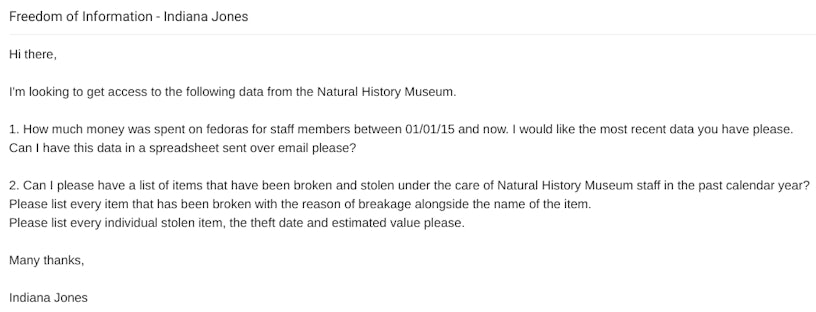You’ve more than likely heard of the power of Freedom of Information (FOI) requests at a conference, in a webinar or on Twitter. But it usually ends there. Perhaps you’ll be told it’s the key to link building success, or it’s the very location of the digital PR holy grail. This can be a daunting prospect, especially if you’ve never ventured into the land of FOI before. If you’re feeling like going on a journey of discoery, grab your outback fedora, leather jacket, trusty bullwhip and decline any adventures involving crystal skulls.
What is a freedom of information request?
Let’s start from the start. An FOI request allows UK citizens to contact government bodies and organisations to request specific sets of information. Sounds simple. But much like a slightly dated 1981 Steven Spielberg flick, there’s going to be a fair amount of obstacles along the way.
What kind of data can I access using a freedom of information request?
A lost ark’s load. Seriously, there’s so much data to be accessed, but then it’s what you do with it that truly morphs it into a valuable PR campaign. A good way to start is to look at this list of government bodies and go from there. Are you seeking driving data? See the DVLA and DVSA. Does data about the vast dark unknown interest you? Try the UK Space Agency. Or is your client really interested in something specific like how much money is spent on litter picking in the South Downs National Park? There’s an authority just for that.
Think reasonably. Will these authorities hold the data you’re looking for? If you’re unsure, just pick up the phone and save yourself the 20-day waiting time. Government bodies, under the Freedom of Information Act (2000), have uwap to 20 days to respond with the necessary information. Importantly, this information cannot exceed a £450 limit (without extra payment). This limit is calculated in terms of the time it would take to collate the data you are requesting, hence the reason to be specific in your email. If you aren’t specific enough, they may respond for clarification, and this 20-day timer resets. It’s a cruel game, so ensure you get it right the first time around.
How do I contact FOI officers?
I’ll let you in on a data archaeologist’s secret; it’s not the best idea to just google “FOI email” + “government body”, because a lot of the time the sites aren’t optimised to rank for such terms. On top of that, in some instances the email cannot be found on any website because it’s hidden away in a contact form. It’s always best to go directly to the government body’s respective website and search for a specific FOI page. This can often be found in the footer or through a site search. Beware! There may not always be a dedicated website for certain bodies, you may have to go to local councils and find the relevant page within their domain.
How do I write an FOI email?
Your email needs to be concise and precise, in fact, I’d say overly precise. If your email is your treasure map, you need the exact millimetre of where that treasure is. No ‘X marks the spot’ here, you need to know everything that you want from this exchange and you need to make that incredibly clear. Think more Google Maps with live traffic updates compared to a crusty piece of parchment paper.
Without insulting any FOI officers (they do an excellent job and they have a huge amount of data on their hands) if you aren’t as clear as you can possibly be, it’s going to delay or disrupt the entire process. They will request clarification and this will reset the timer on your 20 days, not great if you’re trying to fit this into a wider marketing plan.
WhatDoTheyKnow is a website dedicated to showing people how to make FOI requests and also revealing how successful previous requests have been with their respective organisations. This is not only a great way to start your ideation, but it also gives some examples of emails to the FOI officers. My personal tips are the following:
- Keep it short and sweet
- Number your questions
- Include your full name
- Write down every possible detail
- Get rid of fluff (how are you, etc)
- Don’t reference any acts/laws
- Don’t say what it’s to be used for – unless you think this will help to explain your data request
When you are wording your individual questions, consider the following structure:
What – Explain simply exactly what action(s) you want to discover more about
Where – Write that you want to find out where the event(s) happened
When – State the exact date range you are looking to investigate write this out in 00/00/00
Why – Alert the officer if you are looking for reasons why certain actions happened
Who – This should already be answered by the fact you are emailing a certain government organisation
How – Tell the officer how you want the data to be sent by you, typically this is an emailed spreadsheet

How do I get links from FOI data?
The big question. You’ve done all the hard work and now you want to reap the rewards. Now you’ve got the data, you’ve actually got the hardest part of the entire campaign to go. If anything, you’ve just been given the secret key to the temple, but now you’ve got to navigate the media maze within and swipe those hard-earned links.
In short, to get links from FOI data you need to create a story. Fortunately, we have a blog on how to find stories in your data ready for you to get your teeth into straight away!
Analysing your data can be a hard and lengthy process, especially if you’ve requested data from multiple regions or authorities. If you don’t read the above blog on finding stories (it’s a great sequel to this so you should), keep your angles simple and split your datasets into manageable chunks to help you and the journalist understand the story.
How you want to present this data is entirely up to you and should be considered alongside your own brand guidelines. Sometimes presenting the data in a simple table format is the best way forward, however creating an in-depth interactive graphic can also help you to stand out amongst any other would-be treasure hunters.
FOI campaigns aren’t quick, but if you keep it simple, they can certainly be easy. Have you had success with FOI requests before? Let me know in the comments or over on twitter @DriscollDigital.



